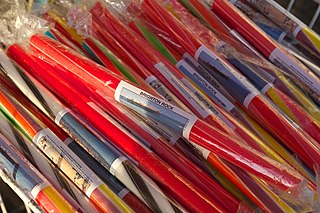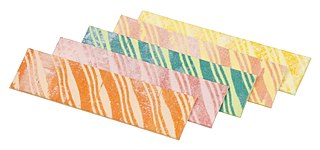This article needs additional citations for verification .(January 2016) |
A Keller Machine is a machine for bending candy cane sticks.
This article needs additional citations for verification .(January 2016) |
A Keller Machine is a machine for bending candy cane sticks.
Patent #2,956,520 for a "candy cane forming machine" was issued on October 18, 1960 to Fr. Gregory H. Keller, a Roman Catholic priest who aside from his parish ministry helped his brother-in-law with his candy company. The patent was originally co-assigned to Robert E. McCormack. [1] Robert McCormack was the founder of Bobs Candies. [2]

First, candy sticks cut to the desired length enter the machine. Each stick is bent individually, but the machine has a system of multiple grippers and rollers to continually bend the sticks, one after the other. As each stick enters the machine, it is positioned in a gripper which holds the straight portion of the cane with the part to be bent protruding out. Each gripper has on one side a curved die which the protruding end will be bent over. The candy stick is first bent to a right angle as it is moved past and put into contact with an inclined face. The patent application describes two potential versions of the mechanism which complete the bending process.
The first version of the mechanism has a chain around two sprockets on which are mounted bending rollers. Each bending roller is attached to a cam which rides along another inclined face to move the roller along the protruding surface of the cane to complete bending it around the die. In the second version, the chain and sprockets are replaced by a wheel on which the bending rollers are mounted.
In modern candy cane production, the sticks are wrapped in cellophane before they are bent. [3]
Bobs Candies was sold to Farley's and Sathers in Spring 2005. [4] Farley's and Sathers merged with the Ferrara Candy Company which continues to make candy canes under the Bobs name.

A cotton gin—meaning "cotton engine"—is a machine that quickly and easily separates cotton fibers from their seeds, enabling much greater productivity than manual cotton separation. The separated seeds may be used to grow more cotton or to produce cottonseed oil.

Continuous track or tracked treads are a system of vehicle propulsion used in tracked vehicles, running on a continuous band of treads or track plates driven by two or more wheels. The large surface area of the tracks distributes the weight of the vehicle better than steel or rubber tyres on an equivalent vehicle, enabling continuous tracked vehicles to traverse soft ground with less likelihood of becoming stuck due to sinking.

Rock is a type of hard stick-shaped boiled sugar confectionery most usually flavoured with peppermint or spearmint. It is commonly sold at tourist resorts in the United Kingdom and Ireland ; in Gibraltar; in Denmark in towns such as Løkken and Ebeltoft; and in Sydney and Tasmania, Australia.

A candy cane is a cane-shaped stick candy often associated with Christmastide as well as Saint Nicholas Day. It is traditionally white with red stripes and flavored with peppermint, but the canes also come in a variety of other flavors and colors.

Roller chain or bush roller chain is the type of chain drive most commonly used for transmission of mechanical power on many kinds of domestic, industrial and agricultural machinery, including conveyors, wire- and tube-drawing machines, printing presses, cars, motorcycles, and bicycles. It consists of a series of short cylindrical rollers held together by side links. It is driven by a toothed wheel called a sprocket. It is a simple, reliable, and efficient means of power transmission.

A chain gun is a type of autocannon or machine gun that uses an external source of power to cycle the weapon's action via a continuous loop of chain, similar to that used on a motorcycle or bicycle, instead of diverting excess energy from the cartridges' propellant as in a typical automatic firearm.

In mechanical or automotive engineering, a freewheel or overrunning clutch is a device in a transmission that disengages the driveshaft from the driven shaft when the driven shaft rotates faster than the driveshaft. An overdrive is sometimes mistakenly called a freewheel, but is otherwise unrelated.

A sprocket, sprocket-wheel or chainwheel is a profiled wheel with teeth that mesh with a chain, rack or other perforated or indented material. The name 'sprocket' applies generally to any wheel upon which radial projections engage a chain passing over it. It is distinguished from a gear in that sprockets are never meshed together directly, and differs from a pulley in that sprockets have teeth and pulleys are smooth except for timing pulleys used with toothed belts.

A shuffling machine is a machine for randomly shuffling packs of playing cards.

Chain drive is a way of transmitting mechanical power from one place to another. It is often used to convey power to the wheels of a vehicle, particularly bicycles and motorcycles. It is also used in a wide variety of machines besides vehicles.

A saw set is a tool or part of the tool kit for tuning saw blades. It adjusts the set, or distance the saw tooth is bent away from the saw blade. The magnitude of set determines the cut width and prevents the blade of the saw from binding in the wood.

Fruit Stripe was an artificially and naturally flavored fruit chewing gum produced by Beech-Nut in 1960 and discontinued in 2024. The individual pieces of gum were striped and were packaged in zebra-striped wrappers, which also acted as temporary tattoos.
The Ferrara Candy Company is an American candy manufacturer, based in Chicago, Illinois, and owned by the Ferrero Group.

Farley's & Sathers Candy Company was created as an umbrella company to roll up many small companies, brands and products under a common management team. The confectionery business segment is made up of many small companies, often with intertwined relationships and histories.
Bobs Candies are a brand of candy manufactured by the Ferrara Candy Company.

In field hockey, each player carries a stick and cannot take part in the game without it. The stick for an adult is usually in the range 89–95 cm (35–38 in) long. A maximum length of 105 cm (41.3") was stipulated from 2015. The maximum permitted weight is 737 grams. The majority of players use a stick in the range 19 oz to 22 oz. Traditionally hockey sticks were made of hickory, ash or mulberry wood with the head of the sticks being hand carved and therefore required skilled craftsmen to produce. Sticks made of wood continue to be made but the higher grade sticks are now manufactured from composite materials which were first permitted after 1992. These sticks usually contain a combination of fibreglass, aramid fiber and carbon fibre in varying proportions according to the characteristics required.

A chain is a serial assembly of connected pieces, called links, typically made of metal, with an overall character similar to that of a rope in that it is flexible and curved in compression but linear, rigid, and load-bearing in tension. A chain may consist of two or more links. Chains can be classified by their design, which can be dictated by their use:

Stick candy is a long, cylindrical variety of hard candy, usually four to seven inches in length and 1/4 to 1/2 inch in diameter, but in some extraordinary cases up to 14 inches in length and two inches in diameter. Like candy canes, they usually have at least two different colors swirled together in a spiral pattern, resembling a barber's pole.

A walking stick is a device used primarily to aid walking, provide postural stability or support, or assist in maintaining a good posture. Some designs also serve as a fashion accessory, or are used for self-defense.

Shimano Nexus is a brand of bicycle components which includes products such as epicyclical gear hubs, cranksets, shifters, brake levers, hub brakes, hub dynamos, and a CPU for automatically changing gears. The series is primarily aimed at the "comfort" market such as urban commuters and tourers, and as such is not made to withstand the rigours of off-road or mountain biking. The free-wheeling Nexus internal gear hubs are compatible with Shimano's "roller brake", its version of a drum brake, but not with the Shimano disc brakes used with the higher-end Shimano Alfine internal gear hubs.